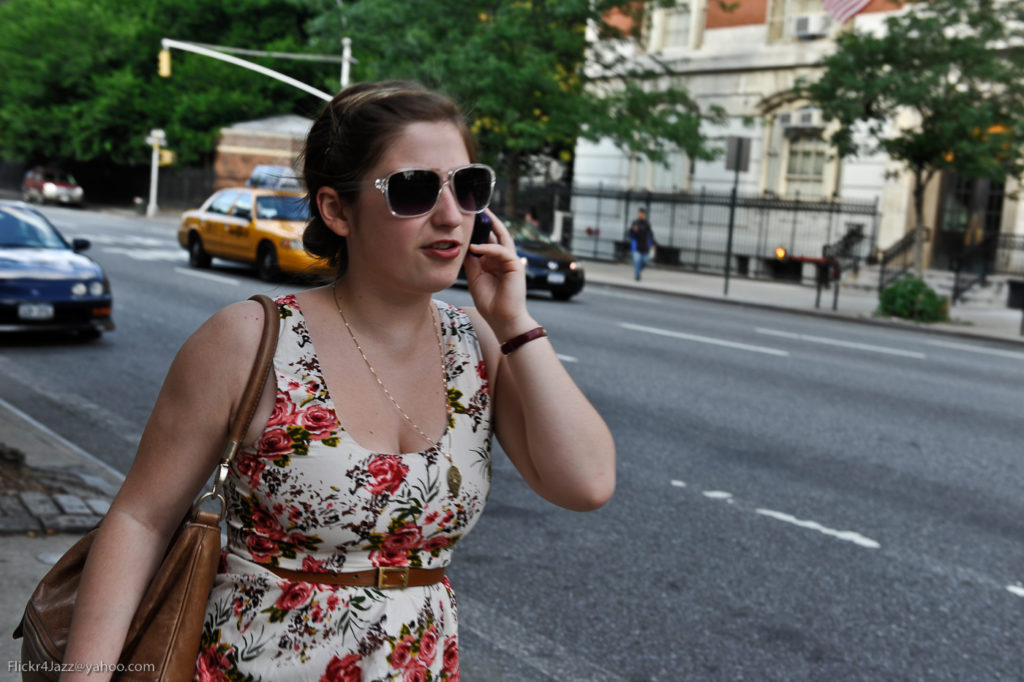
Noodling about New York, the city of my birth, on visits from New England, I’ve noticed the extraordinary dispersal of attention that cell phones and other handheld gizmos have wrought. Many people are simply not where they appear to be. They’re in Louisville or Chappaqua or Queens, muttering emotionally, or twittering as intently as the starlings in the plane trees. Midget keyboarded screens offer an opportunity to type work on the street or gaze at real-time photos from far away or lose oneself in thumbing addictive electronic games.
And yet the purpose of a metropolis includes the effervescence of proximity—whether for business or fun—sharing a bite, a drink or coffee, and reading, not e-mail, but a friend or colleague’s voice as well as his expression, handshake, and body language. With a “great white way”—iconic art museums, jazz clubs, and skyscrapers cheek by jowl—a there was there; whereas now we can download the artwork, the concerts, the signal imagery, and routinely fly higher than Everest between minor destinations.
Despite its putative Manhattan address, the “corner office,” where a company’s strategic decisions on finance and employment are made, may be out in Stamford or on a gated patio in the Sunbelt a thousand miles off. The city’s grand potpourri of ego-crowing towers used to sound their barbaric yawp worldwide, and people still walk with that block-a-minute stride, though rendered half-aware, it might seem, being either plugged into an earpiece or texting animated small talk to San Jose. Has the city become emasculated by computer links, when you can purchase anything from high couture to toxic assets online and download from the public library into your very palm? Is what we call New York being downgraded and eclipsed toward the sort of status we accord Rome and Paris—crossroads cities foreigners needn’t beat a path to anymore except for pleasure visits—as we tout a Yankee Stadium without Babe Ruth, a Macy’s Day Parade without much Macy’s, a Grand Central Terminal diminished of its glamour by 90 percent? My mother worked at Macy’s when my father, living on Murray Hill, met her in Gramercy Park some 80 years ago. A boy who had won a scholarship to go from his Kansas City high school to Yale, he’d worked his way east on a cattle train; then to Europe on a cattle boat for his first vacation. After law school, and when Rockefeller Center had been built, he prided himself on being quartered on the 26th floor, overlooking Fifth Avenue and four blocks down from the sumptuous luncheon club where he entertained colleagues for additional face time. Face time was paramount then, although they did have telephones, and the Superchief would carry you to Los Angeles, the Queen Mary to London.
The club still exists, like a period New Yorker cartoon, but my father’s slave-state racism has been sidelined and hot dog pushcarts stand outside. I’m pleased that Fifth Avenue has become a bit déclassé and that there are vastly huger shifts in sound and coloration through every borough, which could be creating the world’s archetypal universal city, if cities remain germane. But signature architecture like skyscrapers can’t match the cell phone, if people aren’t actually where they appear to be.
The dilution of space by cyberspace may be earthshaking, as species dwindle ever faster, unobserved, and vintage neighborhoods are steamrollered without grief. Not that human nature changes, but the scale and pace of its operations are new. To google Tibetan tarns devalues as well as demystifies them. Union Square, Abingdon Square, Sheridan Square, Washington Square, Tompkins Square, Stuyvesant Square, Madison Square, Sheep Meadow: these locations, precious to me in memory, should not change unrecognizably anytime soon. The question is whether people will continue to live in them, or primarily inside the digitry of their screens. Will Wall Street and Broadway remain kinetic places or merely metaphors, and will people remain alive to what’s tiered and impromptu—not programmed, set, flat, and keypadded for self-censorship? Cities are tall for a reason—even Sana’a, in Yemen, is for its surroundings. But if you don’t want to encounter beggars, transvestites, shell games, or Muslims and Quakers, you won’t have to. You can “work” a farm, then erase it. Will we prefer these simulations for instant gratification to rubbing shoulders catch-as-catch-can? In the country, will quiet listening and observation go by the boards when our attention span has been tailored wholly electronically?
That’s a subject catty-cornered to cities, which already had, for example, the “New York Minute,” not nature’s minute. Yet such a minute was streetwise and energetic, not from treadmilling at a gym and reading Web sites, but from live shticks and faces and bodily hustling all over the place. Even a minute, however, is not fast enough for currency meltdown manipulations performed by virtuoso fingers in Greenwich (our bloated pharmaceutical and pet industries cater to those who’ve missed that boat). Though cities will be less salient, I want them big, unfiltered, indefinable, yet walkable, a maze for liberty off a ship, swelling like a sponge with memories—a place where superheroes, when you were young, sometimes hung out.

